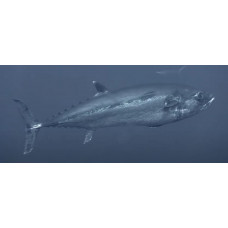Latin name
Gymnosarda unicolor
Other names
White tuna
Identification
They are elongated, somewhat compressed from the sides of the body. The mouth is large. The tip of the upper jaw passes vertically through the center of the eye. Teeth are large, conical. There are 14-31 teeth on the upper jaw and 10-24 teeth on the lower jaw. The tongue has 2 areas covered with teeth. There are 11-14 gill stamens on the first gill arch. There are 48-56 laminae in the olfactory rosette. The interorbital space is 32.1-40% of the length of the head. The caudal peduncle is thin. There is a long medial keel on each side of the caudal peduncle and 2 small keels on either side of it closer to the caudal fin. The trunk and caudal spine each have 19 vertebrae. Liver with elongated left and right lobes and a short central lobe. Except for the corset in the anterior part of the body, the lateral line and the area around the base of the dorsal fin have bare skin. The swim bladder is large. The lateral line is wavy.
Features of fish fins
There are two dorsal fins close together. The first dorsal fin has 13-15 barb rays, the edge of the fin is straight. The second dorsal fin has 17-19 soft rays. Behind the second dorsal fin is a row of 6-7 small fins. Pectoral fins are short, made up of 25-28 rays. They do not reach the imaginary line drawn through the beginning of the gap between the dorsal fins. There is a relatively large single bump between the pelvic fins. The anal fin has 12-13 soft rays. Behind the anal fin is a row of 6 small fins.
Fish colouring
Back and upper body shiny ashy black. Underparts and belly are silvery. There are no spots, lines, or other markings on the body. The leading edge of the first dorsal fin is tawny; other fins are grayish.
Distribution
Widespread in the Indo-Pacific region from the Red Sea and east coast of Africa to French Polynesia; north to Japan and south to Australia.
Habitat
Marine, oceanodromous, tropical species. Depth range from 0 to 250 meters. Often found near reefs, where they are one of the top predators.
Size
The maximum length is 248 cm. The maximum registered mass is 131 kg.
Behavior
They live mainly around coral reefs, usually alone or in small schools of six or less.
Food and feeding habits
They prefer to hunt alone or in small schools and can reach speeds of up to 80 km/h. They prey mainly on small gregarious fish such as Decapterus, Caesio, Nasio, Cirrhilabrus, Pterocaesio and squid.
Reproduction
Breeding is quite active, these fish are extremely prolific. They lay up to half a million eggs at a depth of about 200 meters. The eggs are only about a millimeter in diameter. And each one is equipped with a drop of fat that serves as food for the developing offspring.
Fishing
They are the subject of sport fishing. They are mainly caught with fishing rods.
Relationship with a person
Eating adult fish can cause poisoning.
| Classification | |
| Phylum | Chordata |
| Class | Actinopterygii |
| Squad | Scombriformes |
| Family | Scombridae |
| Genus | Gymnosarda |
| Species | G. unicolor |
| Features | |
| Conservation status | Least Concern |
| Habitat | Pelagic |
| Life span, years | No information |
| Maximum body weight, kg | 131 |
| Maximum length, cm | 248 |
| Sailing speed, m/s | 16,67 |
| Threat to people | Not edible |
| Way of eating | Predator |
Dogtooth tuna
Tags: dogtooth tuna



